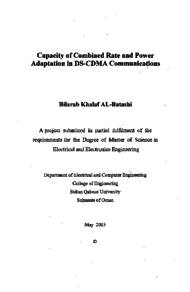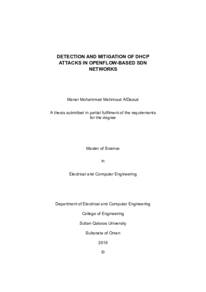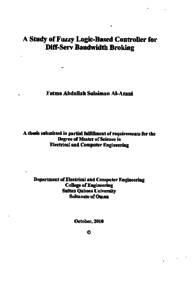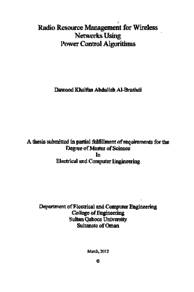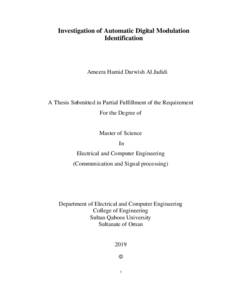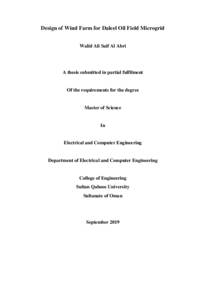وثيقة
Capacity of combined rate and power adaptation in DS-CDMA communications
الناشر
Sultan Qaboos University
ميلادي
2003
اللغة
الأنجليزية
الملخص الإنجليزي
Since system capacity is one of the most important parameters to consider in design of wireless systems, in this project a thorough investigation has been carried out about the integrated voice and data transmission system in order to increase its capacity. The work has been extended by examining the effectiveness of changing rate adaptation for various data rates and the effectiveness of changing modulation techniques. Since forward error correction code (FECC) can improve system capacity for fading channel in similar way as rate adaptation, rate adaptation and FECC have been compared for the effect on the system capacity. BCH code of different code rates are investigated in detail to improve the system performance during fading. The obtained results have been compared with those of the power adaptation system alone for both voice and data under the same conditions. After that the capacity of the combined rate and power adaptation system under different conditions and with system using FECC will be discussed. Finally the main points are summarized in the conclusion.
The results show that, the system using combined adaptations provides higher capacity than that using power adaptation alone for both voice and data. This is because rate adaptation provides power gain to data users that produce less interference to other users leading to capacity increase. The results also indicate that the capacity in both schemes (combined and power adaptation) increases as modulation techniques change from BPSK to MPSK for small modulation level (M). However, these capacities increase as the modulation level (M) decreases. The system using 4PSK provides highest capacity. Moreover, using BCH Code for both schemes will extend the system capacity. Therefore, the capacity can be enhanced greatly by choosing the right combination of modulation level (M) and code rate (I). I is clear from the results that systems using 4PSK with code rate of r=0.286 and r=0.5 provide the highest capacity.
المجموعة
URL المصدر
الملخص العربي
تعتبر الطاقة الاستيعابية ( السعة ) من أهم العوامل الأساسية التي يجب أخذها بعين الاعتبار عند تصميم أنظمة الاتصالات وخاصة أنظمة الهواتف النقالة. ومن هذا المنطلق تأتي هذه الدراسة لهدف مواصلة البحث عن العوامل المؤثرة على السعة خاصة في الأنظمة المتكاملة أو المدبحة ( بيانات مع الصوت والصورة وغيرها ) بغية الوصول إلى نظام ذات طاقة استيعابية عالية. لقد تمت دراسة تأثير ت ير معدل إرسال البيانات (Rate) adaptation على السعة. كذلك دراسة تأثير تسير التضمين (Modulation) من التضمين ثنائي القطب (BPSK) إلى التضمين المتعدد متغير المراحل ( MPSK ) إضافة إلى إدخال تقنية التشفير عليها. تم عمل الدراسة على نظام دمج تكيف طاقة الإرس ال ومعدل إرسال البيانات معا ( Combined Power and Rate Adaptation) ومقارنة هذه النتائج مع تلك التي تم الحصول عليها باستخدام نظام تكيف طاقة الإرسال (Power Adaptation ) فقط.
تظهر نتائج البحث أن استخدام نظام الدمج ( Combined) يؤدي إلى زيادة الطاقة الاستيعابية ( السعة ) للنظام مقارنة باستخدام نظام تكيف طاقة الإرسال فقط وذلك لان طاقة الإرسال للنظام الأول تكون اقل مما يؤدي إلى تقليل نسبة التشويش أو التداخل وبالتالي ينعكس إيجابا على زيادة في السعة. كذلك فان استخدام التضمين المتعدد متغير المراحل ( MPSK ) بدل من التضمين ثنائي القطب (BPSK) يؤدي إلى زيادة السعة. إلا إن هذه السعة تقل كلما زادت المراحل وذلك بسبب طاقة الإرسال العالية المطلوبة لتلك المراحل. بينما تزيد السعة عند إضافة التشفير على تقنيات التضمين. وبشكل ع ام يمكن القول إن السعة يمكن زيادتها باختيار تقنيات التضمين والتشفير المناسبة . لذا تخلص الدراسة إلى إن باستخدام تضمين ذات المراحل الأربعة ( PSK-4 ) مع إضافة التشفير ذات العوامل (code rate) 6 . 5 أو 0 . 268 يمكن الحصول على أعلى سعة للنظام.
تظهر نتائج البحث أن استخدام نظام الدمج ( Combined) يؤدي إلى زيادة الطاقة الاستيعابية ( السعة ) للنظام مقارنة باستخدام نظام تكيف طاقة الإرسال فقط وذلك لان طاقة الإرسال للنظام الأول تكون اقل مما يؤدي إلى تقليل نسبة التشويش أو التداخل وبالتالي ينعكس إيجابا على زيادة في السعة. كذلك فان استخدام التضمين المتعدد متغير المراحل ( MPSK ) بدل من التضمين ثنائي القطب (BPSK) يؤدي إلى زيادة السعة. إلا إن هذه السعة تقل كلما زادت المراحل وذلك بسبب طاقة الإرسال العالية المطلوبة لتلك المراحل. بينما تزيد السعة عند إضافة التشفير على تقنيات التضمين. وبشكل ع ام يمكن القول إن السعة يمكن زيادتها باختيار تقنيات التضمين والتشفير المناسبة . لذا تخلص الدراسة إلى إن باستخدام تضمين ذات المراحل الأربعة ( PSK-4 ) مع إضافة التشفير ذات العوامل (code rate) 6 . 5 أو 0 . 268 يمكن الحصول على أعلى سعة للنظام.
قالب العنصر
الرسائل والأطروحات الجامعية

